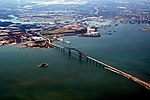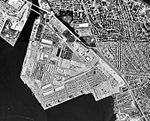Francis Scott Key Bridge replacement
The Francis Scott Key Bridge replacement is a project to replace the Francis Scott Key Bridge in greater Baltimore, Maryland, United States. The Key bridge collapsed on March 26, 2024, after a container ship struck one of its piers. The southernmost crossing of the lower Patapsco River, the bridge was part of the Interstate Highway System and a major piece of the region's transportation infrastructure: a well-trafficked part of the Baltimore Beltway (Interstate 695 or I-695) linking Dundalk in Baltimore County and the Hawkins Point neighborhood of Baltimore. It crossed the deep-water shipping channel leading to the Port of Baltimore, one of the country's busiest ports. Officials at the Maryland Department of Transportation have announced plans to replace the bridge by the fourth quarter of 2028 at an estimated cost of $1.7 billion to $1.9 billion.
Excerpt from the Wikipedia article Francis Scott Key Bridge replacement (License: CC BY-SA 3.0, Authors).Francis Scott Key Bridge replacement
Baltimore Beltway, Baltimore
Geographical coordinates (GPS) Address Nearby Places Show on map
Geographical coordinates (GPS)
| Latitude | Longitude |
|---|---|
| N 39.216944444444 ° | E -76.528333333333 ° |
Address
Francis Scott Key Bridge
Baltimore Beltway
Baltimore
Maryland, United States
Open on Google Maps








